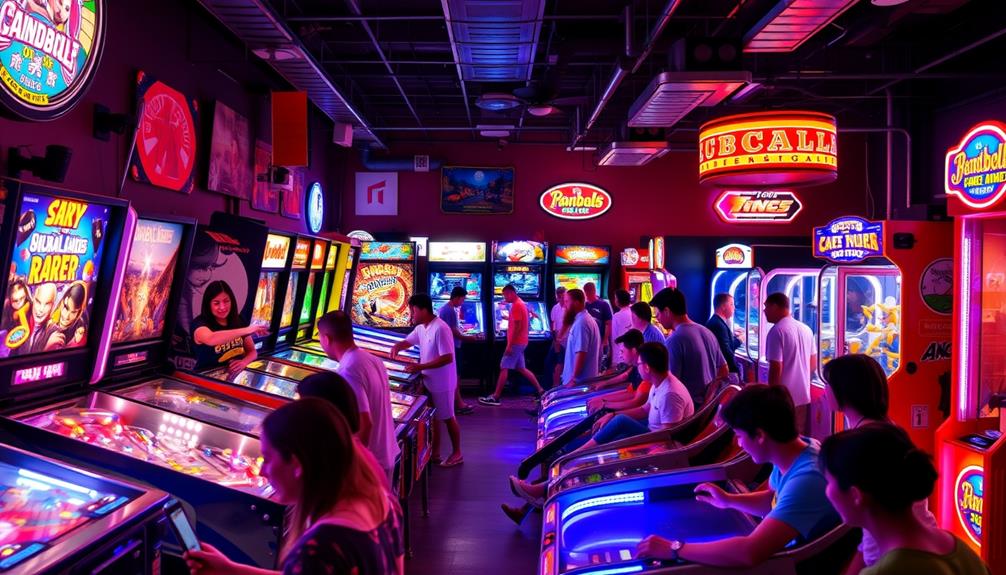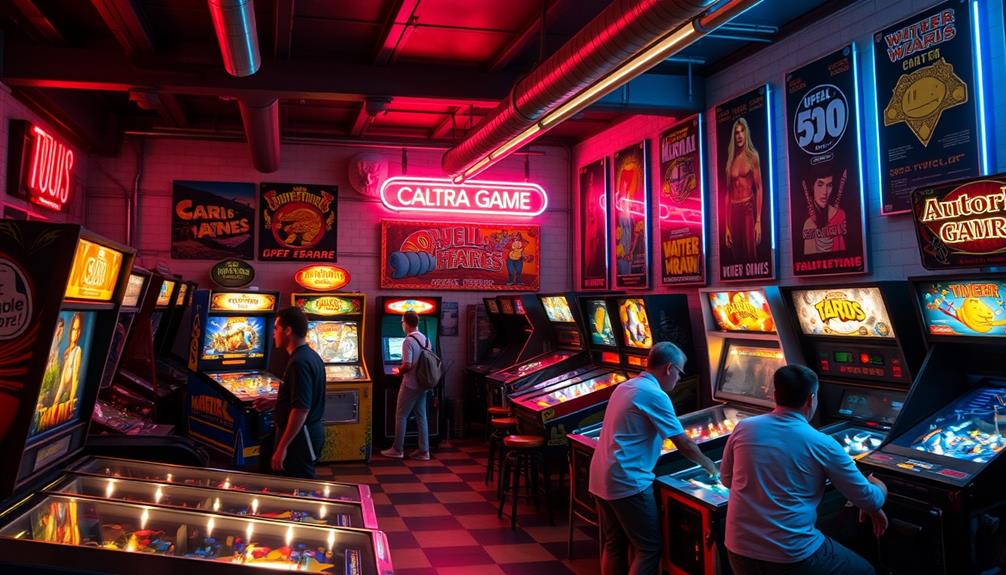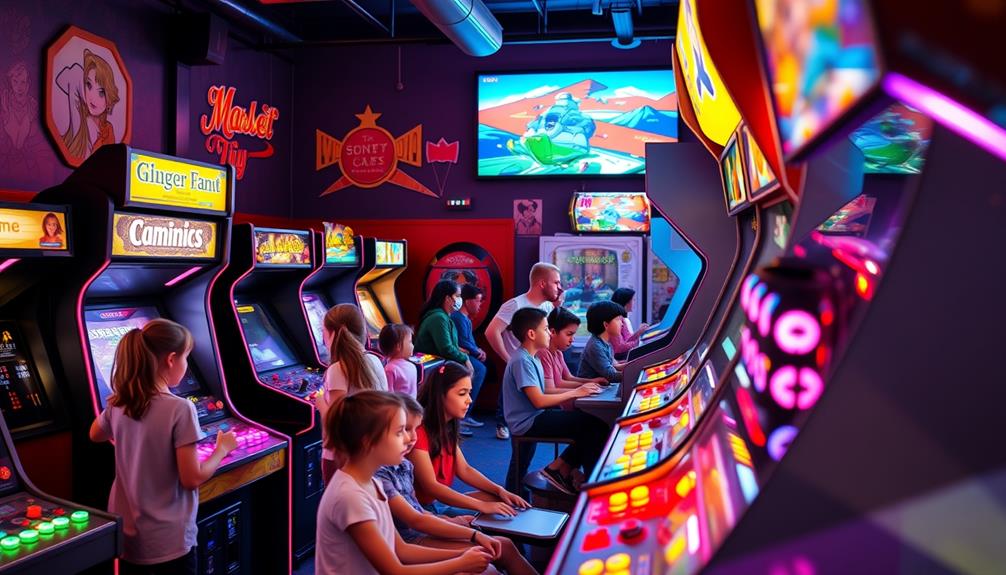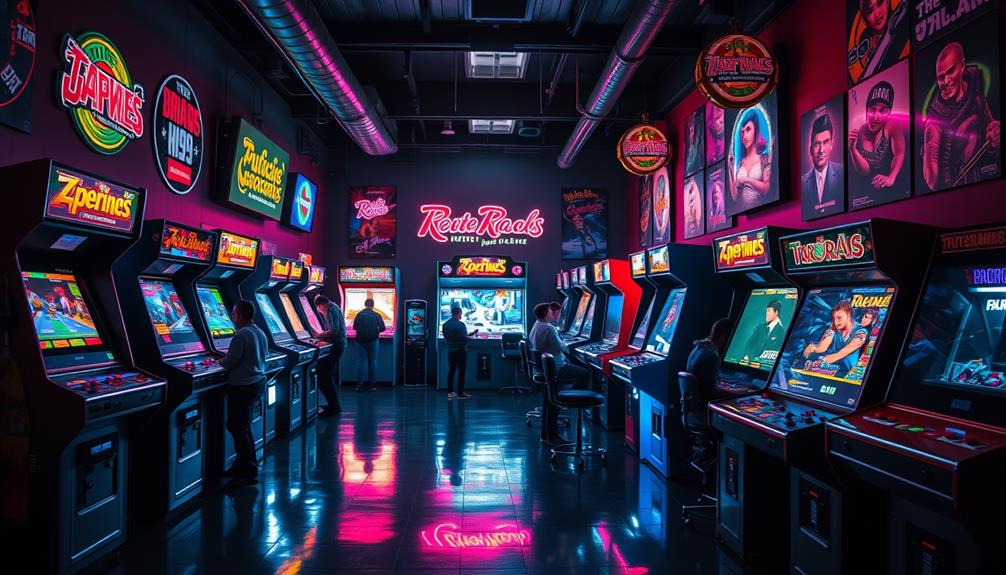Arcade games, commonly known as coin-operated amusement machines, offer a range of interactive experiences created for entertainment and competition. From video games like Dance Dance Revolution that focus on fun rather than prizes, to redemption games like skee-ball that reward players with tickets based on performance, there is something for everyone. Merchandiser games such as claw machines provide the opportunity to win instant prizes. The deep-rooted history and advancing technology of these games have ensured their enduring popularity over the years. Stay tuned to learn more about the intriguing world of arcade gaming and its diverse genres.
Key Takeaways
- Arcade games are interactive entertainment machines designed for amusement, often found in dedicated gaming venues.
- They include various types such as video games, redemption games, and merchandiser games.
- Video games focus on competition and fun, while redemption games reward players with tickets for prizes.
- Merchandiser games, like claw machines, provide direct prizes upon successful gameplay.
- The term "arcade games" encompasses both electronic and mechanical gaming experiences that promote social interaction and competition.
Definition of Arcade Games
Arcade games offer an exhilarating blend of entertainment and competition, enchanting players with their interactive challenges. You'll find these coin-operated machines in dedicated arcades, where they create a vibrant atmosphere filled with excitement.
Designed primarily for amusement, arcade games engage you through a variety of electronic and mechanical experiences, drawing you in with their unique gameplay. Many modern arcade machines feature top-rated options for home game rooms, catering to both casual and serious gamers alike.
These games often require coins or tokens to play, making each session feel like a little adventure. Among the types of arcade games, video games stand out, offering immersive worlds where you can test your skills.
Then there are redemption games, which add an extra layer of fun by rewarding your performance with tickets or prizes. This aspect makes playing even more thrilling, as you endeavor for that high score and the chance to claim awesome rewards.
In essence, arcade games are more than just pastimes; they're interactive challenges that foster competition and excitement. Whether you're battling against friends or trying to beat your own record, the allure of arcade games keeps you coming back for more. The simplicity yet engaging nature of these games makes them appealing to players of all ages, offering a perfect blend of nostalgia and thrill. With arcade games explained as a fusion of skill, strategy, and quick reflexes, it’s easy to see why they’ve stood the test of time. They create a shared experience, bringing people together in an atmosphere of friendly rivalry and pure fun.
Categories of Arcade Games

When you step into an arcade, you'll quickly discover that these entertainment venues host a variety of game categories, each offering a distinct experience.
The first category, video games, focuses on fun and competition, allowing you to enjoy gameplay without the distraction of direct prizes. You can find popular arcade games like Dance Dance Revolution or modern VR games that provide immersive gaming experiences.
Many arcades also feature themed environments that enhance the overall atmosphere, making it a social hub for friends and families to gather and have fun together. In addition, some arcade locations may incorporate unique camping experiences that blend gaming with outdoor activities.
Next, redemption games come into play. These arcade machines reward you with tickets based on your performance, which you can later exchange for cool prizes. Games like skee-ball and basketball hoops are perfect examples of this category, blending skill and reward.
Lastly, there are merchandiser games, which include claw machines and photo booths. These offer direct prizes upon successful gameplay, making them highly attractive for players looking to take something home.
Historical Development

Arcade games have evolved markedly from their origins as early coin-operated machines in amusement parks.
The introduction of pinball machines in the 18th century laid the groundwork for modern arcade entertainment, leading to innovations like the best rated pinball machines of 2024 that highlight the excitement and replay value of the genre.
As video games gained popularity in the late 1970s, they transformed the arcade landscape and created a cultural phenomenon.
You'll see how these developments shaped the gaming experience that we understand today.
Early Coin-Operated Machines
Emerging in the 19th century, the earliest coin-operated machines captivated amusement park patrons with their simple games of skill. These machines laid the groundwork for what would evolve into a thriving arcade gaming industry. One of the first popular forms was the pinball machine, introduced in 1933. Initially, these machines were seen as games of luck due to the lack of flippers, which didn't appear until 1947.
As technology advanced, electro-mechanical (EM) games emerged in the mid-20th century, blending electronic and mechanical components to enhance the gaming experience. These innovations paved the way for more complex gameplay and greater player engagement.
Here's a quick look at the evolution of these machines:
| Year | Machine Type | Key Development |
|---|---|---|
| 1933 | Pinball Machines | Introduced as games of luck |
| 1947 | Pinball Machines | Flippers invented |
| 1971 | Commercial Arcade Video Game | Release of "Computer Space" |
| 1972 | Arcade Games | Launch of "Pong" as a success |
The journey of early coin-operated machines truly set the stage for the vibrant arcade scene we enjoy today.
Rise of Video Games
Video games burst onto the scene in the early 1970s, transforming the landscape of entertainment. The release of "Pong" in 1972 marked the first major commercial success, paving the way for arcade video games.
This momentum continued with "Space Invaders" in 1978, initiating the Golden Age of arcade games. During this time, notable celebrity friendships, like that of Emma Watson and Tom Felton from the Harry Potter sets, reflected the growing cultural relevance of gaming.
This era brought iconic titles that shaped the arcade industry:
- "Pac-Man" (1980) – Captivated audiences with its unique gameplay and character.
- "Donkey Kong" (1981) – Introduced narrative elements and established beloved characters.
- Popular redemption games – Gained traction, offering players prizes and enhancing arcade appeal.
Skill vs. Chance Games

When you step into an arcade, you'll quickly notice a distinct difference between skill and chance games. Skill games require your ability and strategy, demanding focus and practice to improve your performance. In contrast, games of chance rely mostly on luck and random outcomes, offering no skill-based rewards.
Take pinball machines, for example. Initially classified as games of chance, they were redefined as skill games after the introduction of the electric flipper in 1947, allowing players to exert more control. This innovation not only enhanced gameplay but also contributed to the machines' growing popularity in arcades and bars a staple in arcades. This shift changed their regulatory status, as many cities once banned pinball machines, considering them gambling devices.
Redemption games, a subcategory of skill games, reward you with tickets based on how well you play, which can then be exchanged for prizes. This aspect makes them more appealing, as you can see a tangible return for your efforts.
On the other hand, games of chance often face stricter gambling laws due to their reliance on luck. Understanding the distinction between skill and chance games is essential, as it impacts not only your gaming experience but also the legal framework surrounding these arcade attractions.
Redemption and Merchandiser Games

The thrill of arcade gaming often peaks with redemption and merchandiser games, where your efforts translate into tangible rewards. These games not only entertain but also enhance your overall arcade experience by offering exciting incentives.
You might find yourself captivated by the challenge of redemption games, which reward you with tickets based on your performance. Many family-friendly destinations, such as top hotels with water parks, feature these games, adding to the overall fun for visitors. Here are three popular types of these games:
- Skee-Ball: Roll the ball and aim for the highest scoring holes to rack up tickets.
- Stop the Wheel: Spin the wheel and hope for a high ticket payout.
- Sports-themed Games: Test your skills in basketball or soccer challenges.
On the other hand, merchandiser games, like claw machines and photo booths, provide direct prizes from the machine, making the anticipation even more thrilling.
The success of these games hinges on the quality and desirability of the prizes offered, which greatly influences player engagement. Many arcades now integrate e-ticket systems and loyalty programs, encouraging repeat visits as you accumulate tickets or points toward larger prizes.
This dynamic keeps players coming back for more, ensuring a vibrant arcade atmosphere.
Cultural Impact of Arcades

Arcades revolutionized how you interact with others, turning gaming into a social experience where friendships formed over high scores and competition.
This shift paved the way for immersive experiences that blend gaming and socialization, reminiscent of unique party options that enhance celebrations.
The nostalgia for those classic machines still resonates today, sparking a resurgence in retro-themed venues that remind you of simpler times.
As you explore these spaces, you can see how the cultural impact of arcades continues to shape modern gaming and community dynamics.
Social Interaction Dynamics
In bustling arcade halls, players gather to engage in fierce competition and collaborative gameplay, creating vibrant communities around their shared passion for gaming. This social interaction fosters bonds that go beyond just high scores.
Iconic titles like "Street Fighter II" not only popularized competitive gaming but also formed social hubs where players could challenge each other, enhancing the arcade culture. The camaraderie found in arcades mirrors the unique aroma in homes that coffee lovers seek, as both spaces become infused with the energy of shared experiences.
Here are three ways arcades cultivate community:
- Shared Experiences: Players come together, sharing victories and defeats, which deepens connections among them.
- Events and Tournaments: These gatherings attract larger crowds, encouraging newcomers to join and fostering friendships through shared interests.
- Repeat Visits: The camaraderie and social dynamics encourage players to return, ensuring that friendships formed during gameplay continue to thrive.
However, the decline of traditional arcades, especially in regions like Japan, underscores the changing landscape of social gaming venues. As the number of arcades dropped from 26,000 in 1986 to just 4,000 in 2019, it's clear that the community dynamics are shifting.
Despite this, the impact of arcade games on social interaction remains significant and enduring.
Nostalgia and Retro Appeal
Nostalgia plays a powerful role in the allure of arcade games, especially for those who experienced the Golden Age of gaming during the late 1970s and early 1980s. Iconic titles like Pac-Man and Space Invaders didn't just entertain; they became cultural phenomena that defined a generation.
As you reminisce about those days, you might recall the thrill of competing with friends, the sound of coins clinking, and the rush of high scores. Much like how Benatars Daughters' Careers highlight the impact of nostalgia in their fashion empire, the charm of retro games resonates deeply with fans of all ages.
Today, the retro appeal of arcade games is witnessing a revival, drawing in both older players seeking a taste of their youth and younger generations enthusiastic to explore these classics.
The decline of traditional arcades has only intensified this nostalgia, leading many modern gaming spaces to incorporate vintage machines, creating a bridge between past and present. Retro-themed arcade bars and pop-up events have sprung up, emphasizing the cultural significance of these games as a nostalgic entertainment experience.
In this communal environment, you'll find players reliving memories while forging new ones. The resurgence of interest in arcade games showcases their enduring charm and the powerful connection they create through shared experiences.
Technological Evolution

Here are three key developments that shaped this transformation:
- Complex Gameplay: The rise of programmable microprocessors enabled deeper mechanics and challenges, reminiscent of the intricate song structures found in Blue Skies and Lemonade by Rhythm Failure.
- 3D Graphics: By the early 1990s, games like "Virtua Fighter" showcased stunning visuals, revitalizing arcades.
- Virtual Reality Experiences: The 21st century ushered in VR technology, creating truly immersive gaming environments.
These innovations reflect an ongoing commitment to enhancing player experiences, ensuring that arcade games remain relevant and exciting in a rapidly evolving technological landscape.
Modern Arcade Experiences

Arcade games have come a long way from their early days, evolving into vibrant entertainment hubs that offer more than just traditional gameplay. Modern arcade experiences now feature advanced technologies like virtual reality (VR), creating immersive environments that simulate motion and enhance your engagement. You'll find yourself captivated in these interactive spaces, making every visit unique.
Here's a quick look at some key elements of today's arcades:
| Feature | Description |
|---|---|
| Skill-Based Redemption Games | Earn tickets for high scores to redeem prizes. |
| Multiplayer Options | Engage with friends in games like Hologate. |
| Game Releases | Regular updates keep the experience fresh. |
The rise of themed, immersive gaming environments adds layers of storytelling to your adventures, making you feel like part of the game. Plus, the integration of mobile gaming trends helps maintain customer interest and encourages repeat visits. With so much to offer, modern arcades provide a community-focused atmosphere that keeps you coming back for more fun!
Popular Game Genres

When you think about arcade games, you'll find a mix of exciting genres that keep players coming back for more.
From the fast-paced thrills of video games to the fun of redemption games where you earn tickets for prizes, there's something for everyone.
Let's explore these popular game categories and see what makes them so engaging!
Video Game Categories
Exploring the vibrant world of video game categories reveals a diverse array of genres that captivate players of all ages. Among the most popular genres found in arcade cabinets, you'll discover video games that offer thrilling experiences and varied gameplay.
Here are three key types:
- Driving Games: These games let you race against the clock or compete with friends. Titles like "Daytona USA" bring excitement and adrenaline to the arcade.
- Fighting Games: If you enjoy competitive gameplay, fighting games like "Street Fighter II" allow you to battle opponents with unique characters and moves, creating a dynamic atmosphere.
- Light Gun Games: Engaging and interactive, these games require quick reflexes as you aim and shoot at targets, with classics like "Time Crisis" leading the charge.
In contrast to redemption games that reward players with tickets and merchandiser games that offer immediate prizes, video games focus on skill and competition.
The evolution of technology, such as virtual reality, continues to enrich these categories, ensuring there's something for everyone in the arcade!
Redemption Game Types
The thrill of redemption games captivates players as they earn tickets based on their performance, turning gameplay into a rewarding experience.
In arcades, you'll find popular redemption games like Skee-Ball, where you roll balls up a ramp to score points and rack up those coveted ticket rewards. Another classic option is Stop the Wheel; just spin the wheel and hope it lands on a high-value spot for maximum tickets.
Video redemption games add a modern twist, combining skill-based gameplay with ticket rewards. Racing and shooting simulators attract a diverse audience looking for engaging experiences, making them a staple in many arcades.
Then there are claw machines—these mechanical wonders test your precision as you try to snag toys or prizes from within, often requiring a bit of strategy to achieve success.
The appeal of these redemption games lies in their ability to boost customer engagement. You're not just playing for fun; you're motivated to return to accumulate tickets and redeem them for those desirable rewards.
Terminology in Arcade Gaming

Arcade gaming boasts a unique vocabulary that enhances the experience for players and enthusiasts alike. Understanding the terminology can deepen your appreciation for the variety of games available in a typical arcade. One of the most iconic terms in arcade gaming is “spinner.” This refers to a control mechanism that allows players to manipulate the direction or speed of their in-game character. Some of the best arcade games with spinners include classics such as Tempest, Asteroids, and Warlords. Mastering the use of spinners in these games adds an extra layer of skill and strategy to the gameplay, making them even more enjoyable for arcade enthusiasts.
Here are three key categories to know:
- Coin-operated amusement machines: Most arcade games fall under this category, requiring you to insert coins or tokens to play.
- Redemption games: These are designed to reward you with tickets based on your performance, which can be exchanged for prizes.
- Electro-mechanical games: Classic machines like pinball rely on a mix of electronic and mechanical components, showcasing the evolution of gaming.
You'll also encounter video game arcade machines, which feature iconic titles from the 1980s and 90s, like Pac-Man and Space Invaders.
Additionally, merchandiser games offer instant prizes, with claw machines and photo booths standing out in this category.
Familiarizing yourself with these terms will enhance your arcade experience and help you navigate the exciting world of arcade gaming!
Frequently Asked Questions
What Is Another Word for Arcade Games?
When you think about arcade games, you might use terms like "amusement games" or "coin-op games." These phrases capture the essence of the fun and competition you experience while playing at gaming venues.
What Genre Is Arcade Games?
When you explore arcade games, you'll find genres like video games that entertain, redemption games that reward, and merchandiser games that engage. Each genre offers unique experiences, appealing to different player preferences and competitive spirits.
What Are the Classification of Arcade Games?
Arcade games classify into three main types: Video games focus on entertainment, Redemption games reward you with tickets for prizes, and Merchandiser games give instant prizes. Each caters to different player experiences and interests.
What Kind of Game Is Arcade?
Arcade games are interactive entertainment experiences that combine skill and chance. You engage with various genres, from video games to redemption games, enjoying competition, social interaction, and the thrill of earning rewards through gameplay. When it comes to arcade games vs video games, arcade games typically have a shorter playtime and are designed for quick, intense bursts of gameplay. This often creates a more social atmosphere as players take turns on the machines and compete for high scores. On the other hand, video games are typically designed for longer, more in-depth gaming sessions and can be played alone or online with others. Both offer unique experiences and cater to different preferences in interactive entertainment.
Conclusion
In the vibrant world of arcade games, you'll find a rich tapestry woven with history, skill, and technology. From classic cabinets to immersive experiences, these games have evolved but still capture the thrill of competition and chance. Whether you're chasing high scores or snagging prizes, the joy of arcade gaming never fades. So, step up to the machine and let the adventure begin—after all, life's a game, and every play counts!









